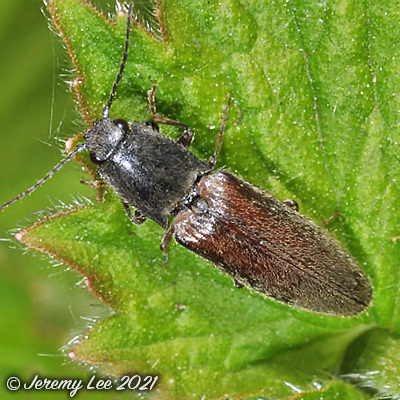
 |
|
Scientific Classifications explained » Amphibians » Ants » Aphids » Bees » Beetles » Birds » Bugs » Butterflies » Caterpillars » Damselflies » Dragonflies » Earwigs » Flies » Frog/Leafhoppers » Fungi » Galls » Grasshoppers » Harvestmen » Hoverflies » Lacewings » Ladybirds » Leaf Mines » Lichens » Mammals » Millipedes » Mosses » Moths » Sawflies » Slugs » Snails » Spiders » Trees » Wasps » Wild Flowers » Woodlice |
UK Nature > Beetles > Athous haemorrhoidalis

Scientific Name: Athous haemorrhoidalis Common Name: Click Beetle 10-15mm in length, Athous haemorrhoidalis, a click beetle, is an elongated species with a relatively long pronotum. The elytra are a red/brown colour with a slightly darker line running down the centre. The elytra are shallowly pitted in rows down their lengths. The pronotum is a noticeably darker brown than the elytra. There is a dense covering of lighter brown hairs. The legs are similar in colour to the elytra, lightening on the tarsi. The antennae are slightly shorter than the length of the head and pronotum. One of the most common Elaterids in Britain. Very common and widespread in England and Wales, common in Scotland. Ubiquitous, occuring in a wide range of habitats including broadleaved, mixed and coniferous woodland, grasslands, parks and gardens, coastal areas and agricultural land. |
|

https://www.uknature.co.uk is a website dedicated to showing the immense diversity of UK nature and wildlife. Our vast range of habitats, from lowland arable to snow covered mountains, from storm-ravaged coastlines to peaceful inland freshwater lakes and rivers, from dry, sandy heaths to deciduous and coniferous forests, all these habitats contribute to the abundance of UK nature. We have wild birds in huge numbers either residing or visiting our shores (597 recorded species as at July 2013) and we must also not forget the humble back garden with its grass lawns, flower beds filled with nectar rich flowers, shrubs and trees, all designed to attract huge numbers of insects such as bees, moths, butterflies and hoverflies; and finally the small ponds which provide safe havens for frogs, toads, newts and even slow worms and grass snakes. www.uknature.co.uk is the showcase for my personal passion, photographing uknature in all its glory. I sincerely hope you all enjoy the fruits of my labours. This site and all images contained therein is © Jeremy Lee 2004 - 2021. All Rights Reserved. Site design by Jeremy Lee. Site development & IT Support by Stuart Lee. |